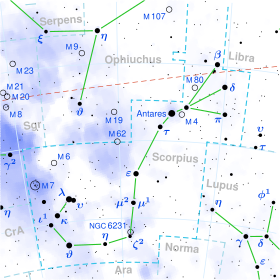Epsilon Scorpii
Epsilon Scorpii (ε Scorpii, disingkat Eps Sco, ε Sco), secara resmi bernama Larawag[12] adalah bintang yang terletak di sebelah selatan rasi bintang zodiak Skorpio. Bintang ini memiliki magnitudo semu sebesar +2,3,[2] menjadikannya sebagai bintang paling terang kelima di rasi bintang tersebut. Pengukuran paralaks yang dilakukan saat misi Hipparcos menghasilkan perkiraan jarak bintang ini yaitu sekitar 637 tahun cahaya (195 parsec) dari Matahari.[1]
| Data pengamatan Epos J2000 Ekuinoks J2000 | |
|---|---|
| Rasi bintang | Skorpio |
| Asensio rekta | 16j 50m 09,8d[1] |
| Deklinasi | –34° 17′ 36″[1] |
| Magnitudo tampak (V) | +2,310[2] (2,24 - 2,35)[3]) |
| Ciri-ciri | |
| Kelas spektrum | K1 III[4] |
| Indeks warna U−B | +1,147[2] |
| Indeks warna B−V | +1,150[2] |
| Jenis variabel | diduga[3] |
| Astrometri | |
| Kecepatan radial (Rv) | –2,5[5] km/s |
| Gerak diri (μ) | RA: –614,85[1] mdb/thn Dek.: –255,98[1] mdb/thn |
| Paralaks (π) | 51,19±0,22[1] mdb |
| Jarak | 63,7 ± 0,3 tc (19,54 ± 0,08 pc) |
| Magnitudo mutlak (MV) | 0,78 ± 0,04[6] |
| Detail | |
| Massa | 1,24[7] M☉ |
| Radius | 12,6[8] R☉ |
| Gravitasi permukaan (log g) | 2,49[9] |
| Suhu | 4.560[9] K |
| Metalisitas [Fe/H] | –0,17[9] |
| Kecepatan rotasi (v sin i) | 2,6 ± 0,5[10] km/s |
| Penamaan lain | |
| Referensi basis data | |
| SIMBAD | data |
Epsilon Scorpii tergolong dalam kelas K1 III,[4] yang menandakan bahwa bintang ini telah kehabisan pasokan hidrogen pada intinya dan berevolusi menjadi bintang raksasa. Diameter sudut yang diukur dengan interferometri, setelah penggelapan tepi dipastikan sudah tepat, adalah sebesar 5,99 ± 0,06 mas,[13] yang pada jarak perkiraannya, sama dengan jari-jari fisik hampir 13 kali jari-jari Matahari. Saat ini, Epsilon Scorpii menghasilkan energi melalui fusi nuklir helium pada intinya, mengingat bahwa komposisi bintang ini menempatkannya di sepanjang cabang evolusi yang dikenal dengan istilah red clump (rumpun merah).[14] Atmosfer luar bintang ini memiliki suhu efektif sebesar 4.560 K,[9] sehingga bintang ini terlihat memancarkan rona jingga seperti bintang tipe K yang dingin.
ε Scorpii diduga merupakan bintang variabel,[3] meskipun kajian fotometri Hipparcos menunjukkan variasi magnitudo yang tidak lebih dari 0,01–0,02.[14] Bintang ini juga merupakan sumber sinar-X dengan luminositas sebesar (1,5–1,6) × 1027 erg s−1.[6][15]
Referensi sunting
- ^ a b c d e f van Leeuwen, F. (November 2007), "Validation of the new Hipparcos reduction", Astronomy and Astrophysics, 474 (2): 653–664, arXiv:0708.1752 , Bibcode:2007A&A...474..653V, doi:10.1051/0004-6361:20078357
- ^ a b c d Gutierrez-Moreno, Adelina; Moreno, Hugo (Juni 1968), "A photometric investigation of the Scorpio-Centaurus association", Astrophysical Journal Supplement, 15: 459, Bibcode:1968ApJS...15..459G, doi:10.1086/190168
- ^ a b c Samus, N. N.; Durlevich, O. V.; et al. (2009). "VizieR Online Data Catalog: General Catalogue of Variable Stars (Samus+ 2007–2013)". VizieR On-line Data Catalog: B/gcvs. Originally Published in: 2009yCat....102025S. 1: 02025. Bibcode:2009yCat....102025S.
- ^ a b Gray, R. O.; et al. (Juli 2006), "Contributions to the Nearby Stars (NStars) Project: spectroscopy of stars earlier than M0 within 40 pc-The Southern Sample", The Astronomical Journal, 132 (1): 161–170, arXiv:astro-ph/0603770 , Bibcode:2006AJ....132..161G, doi:10.1086/504637
- ^ Wielen, R.; et al. (1999), Sixth Catalogue of Fundamental Stars (FK6). Part I. Basic fundamental stars with direct solutions (35), Astronomisches Rechen-Institut Heidelberg, Bibcode:1999VeARI..35....1W
- ^ a b Schroeder, K.-P.; Huensch, M.; Schmitt, J. H. M. M. (Juli 1988), "X-ray activity and evolutionary status of late-type giants", Astronomy and Astrophysics, 335: 591–595, Bibcode:1998A&A...335..591S
- ^ Fuhrmann, K; Chini, R; Kaderhandt, L; Chen, Z (2017). "Multiplicity among Solar-type Stars". The Astrophysical Journal. 836: 139. Bibcode:2017ApJ...836..139F. doi:10.3847/1538-4357/836/1/139.
- ^ Lang, Kenneth R. (2006), Astrophysical formulae, Astronomy and astrophysics library, 1 (edisi ke-3), Birkhäuser, ISBN 3-540-29692-1. Jari-jari tersebut (R*) berasal dari perhitungan:
- ^ a b c d McWilliam, Andrew (Desember 1990), "High-resolution spectroscopic survey of 671 GK giants", Astrophysical Journal Supplement Series, 74: 1075–1128, Bibcode:1990ApJS...74.1075M, doi:10.1086/191527
- ^ Carney, Bruce W.; et al. (Maret 2008), "Rotation and Macroturbulence in Metal-Poor Field Red Giant and Red Horizontal Branch Stars", The Astronomical Journal, 135 (3): 892–906, arXiv:0711.4984 , Bibcode:2008AJ....135..892C, doi:10.1088/0004-6256/135/3/892
- ^ "eps Sco". SIMBAD. Centre de données astronomiques de Strasbourg.
- ^ "Naming Stars". IAU.org. Diakses tanggal 16 Desember 2017.
- ^ Richichi, A.; Percheron, I.; Khristoforova, M. (February 2005), "CHARM2: An updated Catalog of High Angular Resolution Measurements", Astronomy and Astrophysics, 431 (2): 773–777, Bibcode:2005A&A...431..773R, doi:10.1051/0004-6361:20042039
- ^ a b Adelman, Saul J. (2001), "On the Photometric Variability of Red Clump Giants", Baltic Astronomy, 10: 593–597, Bibcode:2001BaltA..10..593A, doi:10.1515/astro-2001-0404
- ^ Gondoin, P. (Desember 1999), "Evolution of X-ray activity and rotation on G-K giants", Astronomy and Astrophysics, 352: 217–227, Bibcode:1999A&A...352..217G
